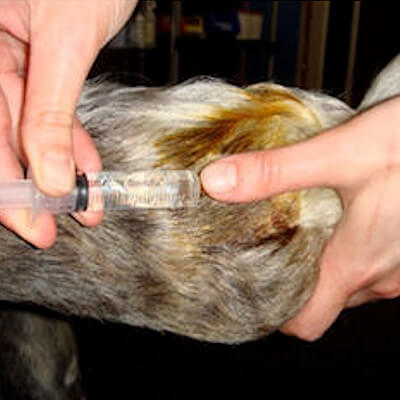Nerve blocks – the lame horse

Lameness is a common problem in horses of all ages and types. It can be frustrating, expensive and time-consuming trying to get to the bottom of the problem. Unfortunately horses, unlike people, cannot tell us the source of pain; hence the need for a variety of diagnostic tests accompanied by often multiple imaging modalities in order for an appropriate diagnosis, treatment plan and prognosis to be made.

Nerve blocks, the correct term being diagnostic anaesthesia, are used daily by equine practitioners to accurately determine the site of pain in lame horses. Occasionally, the site of pain may be immediately obvious with localised signs of heat, pain on palpation and swelling of the affected area. Unfortunately, these indicating signs are often absent in the lame horse.
The aim of a lameness investigation is to provide a thorough, systematic clinical examination and diagnostic anaesthesia to identify the source of pain. Imaging can then be used in the form of radiography, ultrasonography, gamma scintigraphy, computed tomography (CT) and magnetic resonance imaging (MRI) to identify the lesion and determine the most appropriate treatment plan.
Nerve blocks work by injecting local anaesthetic around the nerves which supply sensation to the limb. The local anaesthetic prevents conduction of impulses along the nerve fibre so that the horse is no longer able to feel the source of pain.
To use this principle for diagnostic purposes its essential for nerve blocking to begin at the bottom of the limb. If started at the top, all sensation to the lower limb will be lost and we will be no further in identifying the exact site of the problem. For this reason, most lameness investigations begin with lower limb blocks, usually a palmar digital nerve block in the front limb and a low-6 point nerve block in the hindlimb, due to the high prevalence of foot problems in the forelimbs compared to the hindlimbs.
It is worth mentioning that this is not an exact rule and is dependent on the temperament of your horse and the approach can vary in every case according to the presenting complaint.
This is achieved simply by testing skin sensation beneath the level that the block was performed with a blunt object such as a pen or pair of scissors. If the horse responds to this test, further local anaesthetic will be injected around the nerves until complete loss of skin sensation has been achieved.
This picture shows an abaxial sesamoid nerve block being performed in the forelimb of a horse. This block abolishes sensation to all structures beneath the level of the fetlock.
During the initial clinical examination, your vet will be looking to determine which leg is affected and exactly how lame your horse is. A lameness scoring system is often adopted to grade the degree of lameness before and after blocking. Results are generally most rewarding in a horse with a consistent mild to moderate lameness.
It is not advisable for a horse to be on high levels of phenylbutazone (bute) or to have had a long period of rest prior to a lameness investigation as the lameness is often too mild to be able to block effectively, ie its difficult to appreciate the degree of improvement as the horse is mildly or inconsistenly lame to begin with.
The overall aim is to continue blocking in an upward direction until the lameness improves substantially (at least >50%) or ideally, is abolished altogether. Your vet will identify a zone of the limb, between the previous block and the current block level, within which the problem resides.
Once the lameness has been localised to a region of the limb it may be necessary to perform further specific perineural, joint, tendon sheath or synovial bursa blocks. In the same way, local anaesthetic is placed around nerves (perineural), it can be injected into synovial structures to determine even more precisely the site of pain (joint block). Injection of joints is not without potential complications and should always be performed in sterile conditions to reduce the potential risk of introducing infection to the joint.
Following further specific blocks, the multiple imaging modalities available to your vet can be used to identify the lesion. An accurate diagnosis, treatment plan and prognosis can then be determined for your horse based on these findings.
Nerve blocks are contraindicated in horses that show signs of severe lameness. In cases of severe lameness the possibility of a bone fracture should always be taken into account. If a nerve block is then performed to eliminate sensation to the affected region, the potential for the horse to bear weight excessively on the affected limb exists, which can lead to catastrophic fracture of a previously non-displaced fracture.
Most horses tolerate nerve blocking well, but some horses reactions to the placement of needles makes it impossible to perform. Blocking can be very dangerous, especially in the hindlimb or in unpredictable or nervous horses; the safety of the vet and owner is paramount in this situation. Adequate restraint by a competent handler is essential. In some cases diagnostic anaesthesia is simply too dangerous to perform, in which case other methods of lameness diagnosis will need to be implemented.

Outstanding feature
Excellent write-up